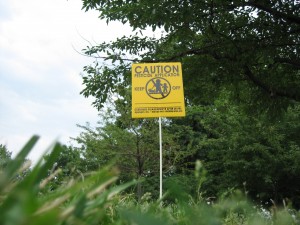23
Jun
Supreme Court Ruling Offers Some Protection from GE Crops
(Beyond Pesticides, June 23, 2010) The Supreme Court ruling in Monsanto v Geersten Seed Farms on June 21, 2010 appears to favor the St. Louis-based biotech giant, but may offer some protection from genetically engineered (GE) crops. In a 7 to 1 decision, the high court overturned a lower court injunction on the planting of GE alfalfa, yet planting the crop still remains illegal until USDA completes assessing its environmental review. Interestingly, Justice Steven G. Breyer recused himself because his brother District Judge Charles Breyer had issued the original ruling, while Justice Clarence Thomas did not recuse himself despite having worked as a Monsanto attorney for two years.
In 2006, the Center for Food Safety (CFS) and several other farming and environmental groups, including Beyond Pesticides, filed suit on behalf of Geerston Seed Farms. The suit led to a U.S. District Court ruling that the U.S. Department of Agriculture (USDA) violated the National Environmental Protection Act (NEPA) by approving the sale of GE alfalfa without requiring an environmental impact statement (EIS). Monstanto was forced to stop selling the seed until a comprehensive EIS is prepared and assessed. A draft EIS was prepared in 2009.
This was the first ever moratorium in the U.S. on a genetically engineered crop. The ruling was upheld in two appeals. The Supreme Court, however, sided with Monsanto and ruled the District Court had overstepped its authority by prohibiting the USDA from pursuing any partial approval of the crop. Justice John Paul Stevens was the only dissenter saying, âIt was reasonable for the court to conclude that planting could not go forward until more complete study … showed that the known problem of gene flow could in reality be prevented.â USDA said it intends to release an EIS in time for spring planting next year.
Though Monsanto’s Steve Welker is quoted in the companyâs press release calling the ruling, âexceptionally good news,â in practical terms, the ruling is more of a victory for Monsantoâs opponents. The Supreme Court did agree with the lower courtâs ruling that the USDA violated NEPA when it approved planting of GE alfalfa. This ruling made GE alfalfa illegal to plant, thus making a ban unnecessary. The Court agreed with CFS that gene flow is a serious environmental and economic threat.
âThe Justicesâ decision today means that the selling and planting of Roundup Ready Alfalfa is illegal. The ban on the crop will remain in place until a full and adequate EIS is prepared by USDA and they officially deregulate the crop. This is a year or more away according to the agency, and even then, a deregulation move may be subject to further litigation if the agencyâs analysis is not adequate,â said Andrew Kimbrell, executive director of CFS. âIn sum, it’s a significant victory in our ongoing fight to protect farmer and consumer choice, the environment and the organic industryâ
Alfalfa is our nationâs fourth largest crop. Grown on 23 million acres, and used primarily for forage, it is the first perennial crop to be genetically modified. It is estimated that before the ban over 260,000 acres of GE alfalfa had been planted in the U.S. by 5,500 growers. GE alfalfa presents a unique risk to organic growers: unlike wind pollinated crops such as corn, alfalfa is pollinated by bees. This results in higher risk of cross pollination between GE alfalfa and unmodified varieties. Growers of GE corn are required to plant a buffer of unmodified corn around their fields to keep pollen carrying engineered genes from contaminating other growersâ fields or wild plants. These regulations have reduced, but not eliminated, the incidence of cross fertilization in corn. In alfalfa fields, these regulations would be even less successful, since bees can carry pollen up to five miles from their hive.
Glyphosate is a known carcinogen, neurotoxin, irritant, and has been found to kill human embryonic cells, and can cause kidney and liver damage. Glyphosate is also harmful to the environment, particularly aquatic life and water quality and has been linked to intersex frogs, and is lethal to amphibians in concentrations found in the environment. Furthermore, the spread of glyphosate resistance is a growing concern: Monsanto is now acknowledging the prevalence of glyphosate resistant weeds. In addition to a shoddy environmental record, Monsanto has also been criticized for its business practices, and is currently undergoing an antitrust probe by the U.S. Department of Justice.
Beyond Pesticides opposes the use of GE crops and supports organic agriculture as effecting good land stewardship and a reduction in hazardous chemical exposures for workers on the farm. For other studies and more information, see Beyond Pesticidesâ GE Program and Organic Program pages.
Sources: New York Times
Huffington Post













